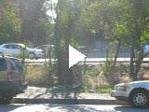After a night at my friend Julia’s apartment and retrieving my bike (which Julia stored in the corner for the week), I biked to Environmental Charter High School near Manhattan Beach in L.A. and talked to two classes of students. The school requires all of its students to take environmental science, and I enjoyed looking at photos on the walls of field trips to natural environments far away from the city school.
Archive for November, 2005
Environmental Charter School in L.A.
Tuesday, November 29th, 2005Carbon Offsets for a Trip to ?!Florida!?
Monday, November 28th, 2005 You may be wondering why the line on the map hasn’t moved in the past week. I’ve been in Florida, spending Thanksgiving with four (!) different generations of my family. I will be missing the next two Christmases, and I figured I could justify flying across the country for Thanksgiving.
Unfortunately, flying across the country uses a lot of fuel. Even though airplaine efficiency has improved in recent years, flying still gives off almost as much carbon dioxide as driving. It is almost as if I drove across the country.
So I have purchased carbon offsets. This means that I am paying someone else to not pollute, or I am paying someone to take carbon dioxide out of the atmosphere. This is similar to how the Kyoto treaty works — if you emit too much carbon dioxide, you have to pay someone else not to emit it.
Flying to Florida, I was responsible for about 1 metric ton of carbon dioxide released to the atmosphere. I have paid $12 to www.climatecare.org to offset these emissions through their various projects.
Anyway, I’m back in L.A. now, about to try to take public transit from this Starbucks to the other side of town (It takes three different busses to get from the Ontario airport to the metro station. And the first bus? It was to the rental car parking lot and I had to ask the driver to make a special stop so that I could take the second bus).
Back to the bike tomorrow!
Biking in L.A. – to Hollywood and Back
Friday, November 18th, 2005After talking with Mr. Ransom’s 9th grade class, I decided to bike through Los Angles to get a sense of the city. Following a city map, I rode 30 miles to Hollywood and back.
I hoped to talk with cyclists to see how they managed to bike in LA. I found only two. One had lost his license, and was forced to bike. I asked if he had trouble with the cars. He replied, “Recently, I was hit by a Mercedes and then my arm was run over by a Lexus.” The man then listed his hospital bills. I biked on the sidewalk (slowly) afterwards.
The climate in L.A. is perfect for year round bicycle commuting, yet few people bike because 1) everything is so spread out and 2) there are few (if any) bikeways or bike lanes. The public transit does work, but only a few people I talked with seemed satisfied with it. Most trips are in a car, and in traffic.
Unfortunately, cars are an inefficient way to travel around a city. A person in a car emits, on average, twice as much carbon dioxide as a person in public transit. Also, by comparison, cycling adds almost no carbon dioxide to the atmosphere (see comment on this).
I would love to see an L.A. with bike lanes and great public transit. It would require great change, but I think it is possible, and I think the city would be far better for it.
Universty High in LA — Can we trust climate models?
Thursday, November 17th, 2005Today I talked at University High School (it’s a high school, not a University) in West Los Angeles. The teacher, Mr. Ransom, who has masters in physics and has used computer models, argued that our models of the climate are simply not good enough to act on. He does not trust them.
Can we trust these computer models predicting future warming? These models break the world into a grid, use basic physical equations, and figure out weather in every cell for the course of a year for many centuries.
While these complicated models are not good at simulating some aspects of the climate (tropical rain patterns and the effects of sea ice, for example), they can generally reproduce the current climate of the planet. Most impressively, we can well simulate changes in temperature over the past century, giving us confidence that we do understand how the world’s climate works. In 2001, the Intergovernmental Panel on Climate Change, which reviewed all current climate science, decided that these models were good enough to make predictions, and the models have improved since then. While Mr. Ransom may have been correct a decade or more ago, I don’t think he is correct any more.
This is why I feel I can make claims about California’s future—the science is good. To see a better defense of climate models, click here. To run a simple one on your own computer, click here.
Ventura to Los Angeles — 1 day, 73 miles
Wednesday, November 16th, 2005For a day in Ventura, in addition to visiting schools, I watched surfers, sat at the beach for sunset, and visited Patagonia. I stopped by the headquarters of environmental friendly and profitable Patagonia, which generates a large portion of their electricity from photovoltaic cells over their parking lot. I also met three cyclists riding south from Vancouver with their own environmental web log.
After staying at the house of a teacher at Cabrillo middle school, I left at dawn to try to avoid the Santa Ana winds. Passing a navy base, I followed the Pacific Coast Highway along the coastal mountains, passing through Malibu and Santa Monica before turning towards West Los Angeles where I met my friend Julia Goodnough.





